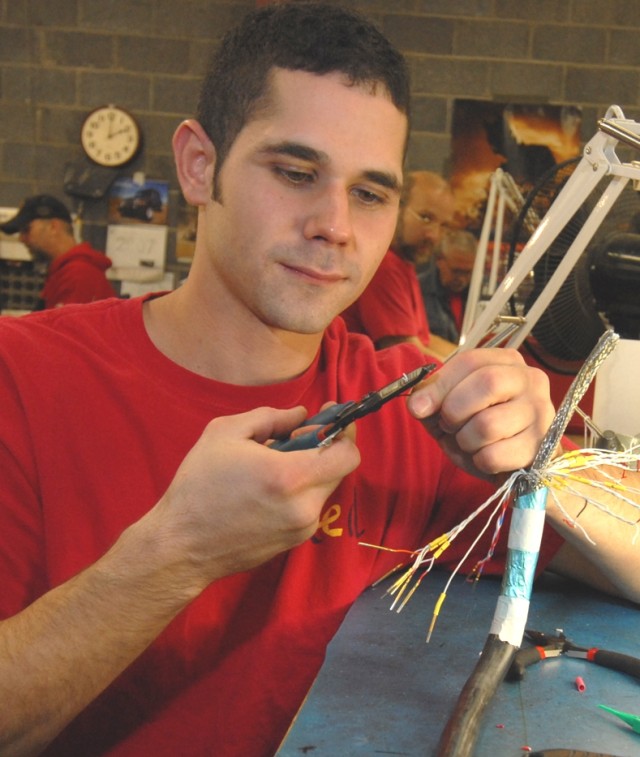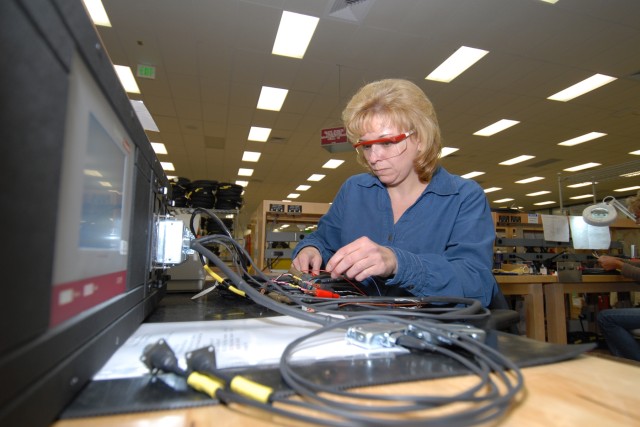TOBYHANNA ARMY DEPOT, Pa. (Army News Service, Nov. 5, 2007) -- Tobyhanna has passed a milestone in producing kits for a key system that enhances situational awareness on the battlefield.
Technicians at the depot produced 50,000 Blue Force Tracking installation kits for the Army and Marine Corps as of Oct. 12. The system not only provides situational awareness, but also helps reduce the risk of fratricide, officials there said.
Blue Force Tracking allows Soldiers and Marines in the field to see where they are via maps displayed on video monitors. It also pinpoints the location of other BFT-equipped units. Field commanders with BFT can observe the same data to maneuver units to more strategic or safer positions. Soldiers and commanders can communicate with each other through radio and e-mail sent by a satellite, which also provides global positioning information.
BFT is composed of computers using Force XXI Battle Command Brigade-and-below software, video monitors, Position Location Ground Radios and satellite antennas.
The depot role includes design and manufacturing of the BFT kits by depot personnel in the Production Engineering and the Systems Integration and Support directorates . The design phase of the mission started in 2001 and technicians in the Electronics Fabrication Support Branch began assembling and installing the kits in 2002.
"The kits are composed of a switchbox, cables, brackets, mounts and other associated hardware," said Joe Healey, a branch leader. "We produce several different kits for shelters, Humvees, trucks, Stryker vehicles and the new MRAP (Mine Resistant Ambush Protected) vehicles."
The switchbox is the link between the BFT communications components and computers.
The cables are fabricated and tested by technicians in the Electrical Fabrication Support, Satellite Systems Support and Tactical Communications Facilities branches, who along with other SIS branch personnel also assemble the kits and package them for shipping.
Technicians in the Automatic Test Equipment Repair Branch test the BFT Tactical Operation Center Light kits.
Other kit components such as mounting brackets are prepared by the Industrial Services and Refinishing divisions.
The Sheet Metal Fabrication Branch and the Machining Branch manufacture metal subcomponents from raw stock, said Michael Fisher, Industrial Services Division chief.
"These include piece parts and subassemblies of brackets and associated items that facilitate mounting of the electronic components into the vehicles," he explained.
"We make or modify switch boxes and switch covers, tripod adapters and brackets" said Paul Hartz, Machining Branch chief.
These sub components move into the Welding Branch, where they are joined into unfinished components.
The next step is taken at the Industrial Operations facility, where the components are etched and painted or plated. Once through the IOF, the raw stock has completed its transformation to a complete item ready for installation.
All components and parts purchased or manufactured are routed to the Assembly Branch, Mr. Fisher said. The Assembly Branch assembles these items into the final product by identifying and packaging the discrete components and parts required for each type of vehicle that receives the kit in accordance with drawings and other technical data.
"There is a variation of 16 different assemblies that we put together and ship," said Robert Abromavage, Assembly Branch chief. "As they come in we separate for the weekly requirements. We install hardware and fasteners and assemble the brackets into completed configurations. We take the completed items, put them together with the installation hardware and cable assemblies. They are then inspected and shipped to the customer's account."
"BFT cable fabrication was started in this branch in May due to increasing workload," said Ron Pugliese, chief of the Tactical Communications Facilities Branch. "We have two shifts going now and will add a third shift in another month."
Jerry Demeck, chief of the Electrical Fabrication Support Branch, said depot and contractor employees are working two shifts because of the current mission.
"In fiscal year 2003, the entire depot had about 2.3 million manhours of work," he said. "This fiscal year, this directorate alone will have 2.4 million man-hours of work.
"We're producing hundreds of kits per week between the three branches," Mr. Healey added.
Victor Narsavage, a Tactical Communications Facilities Branch leader, said they can fabricate thousands of cables monthly.
"Fabricating the cables and switch boxes to meet the demand is very challenging," he said. "They are the most complicated components in the kits."
Personnel from all branches credit teamwork and "Lean" initiatives for being able to meet the schedule.
Mr. Pugliese and Mr. Demeck said a lot of inter-shop coordination must be done. Coordination not only between the three main branches, but also between the other SIS branches, production controllers, engineers, requisitioners and expediters, is crucial to meet the growing demand, they said.
"The people in this mission put quality before quantity," said Bob Olshefski, electrical worker, Electrical Fabrication Support Branch. "Our branch developed more efficient processes to meet the schedule before we implemented Lean techniques. We have a double verification program. Every cable is tested electrically, electronically and mechanically before it goes to the quality personnel for final verification. When Soldiers plug that system in using our kit, the system works."
Mr. Pugliese credits Lean for allowing his entire branch, which works on other satellite communications-related missions, to increase productivity after the BFT mission was added in May. "We worked with PII (Productivity Improvement and Innovation Directorate) to integrate our new equipment into the Lean concept, organizing the branch into cells and using Lean to work towards total Lean automation," he said. "I'm sure we will improve further."
"We have not only the BFT kits, but also the spare cables and other parts, and our other missions. I expect this mission to grow. It seems the more kits and spares we send, the more demand we get," Mr. Demeck point out.
Jason Keyser, a contractor employee in the Electronics Fabrication Support Branch who has worked on the mission for three years, said he appreciates the depot work ethic. "I'm very impressed with the pride people here take in their work. They meet schedules all the time."
John Kalenak, production controller, says that although Tobyhanna normally ships kits to Red River Army Depot, Texas, for distribution to units, they also regularly received urgent requests from the field.
"We have been contacted from units all over the world, especially from Southwest Asia, who need BFT kits shipped to them directly," he said. "We absolutely have been able to meet those requirements. It's not uncommon for us to send a group of kits in one direction and another group in another direction."
Debbie Shea. Manufacturing Scheduling Division chief, said Tobyhanna produced thousands of spare cables last year alone and will produce thousands more in fiscal year 2008.
"We are exceeding the demand for the top three priority kits and meeting demand for all other types of kits," she said.
Mr. Kalenak, who served in the Air Force, said it feels good to be able to consistently fulfill troop requirements.
"I'm sure everyone here feels the same way," he said. "We have a fabulous team with fantastic support from all of our shops involved here at Tobyhanna."
A former security guard who deployed to Iraq in 2004 and 2005, used Blue Force Tracking while on duty there.
"A great system!" said the Army Reserve staff sergeant. "I have convoyed with BFT and without. Its presence in my vehicle was a comforting enhancement. The terrain we covered daily wasn't always familiar and that birds-eye view of our vehicle, the rest of our forces, and the environment significantly increased situational awareness."
"There is not a person working this mission anywhere on the depot who doesn't take pride in this work," said Robert Tambasco, a Tactical Communications Facilities Branch electronic worker. "They know where the final product goes, the Soldier."
Tobyhanna Army Depot is the Defense Department's largest center for the repair, overhaul and fabrication of a wide variety of electronics systems and components, from tactical field radios to the ground terminals for the defense satellite communications network. Tobyhanna's missions support all branches of the Armed Forces.
About 5,100 personnel are employed at Tobyhanna, which is located in the Pocono Mountains of northeastern Pennsylvania.
Tobyhanna Army Depot is part of the U.S. Army Communications-Electronics Life Cycle Management Command. Headquartered at Fort Monmouth, N.J., the command's mission is to research, develop, acquire, field and sustain communications, command, control, computer, intelligence, electronic warfare and sensors capabilities for the Armed Forces.
(Anthony Ricchiazzi serves with the Tobyhanna Army Depot Public Affairs Office.)




Social Sharing